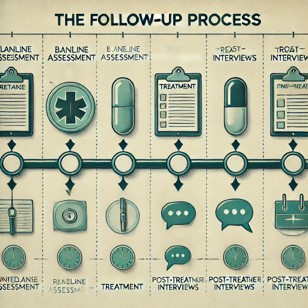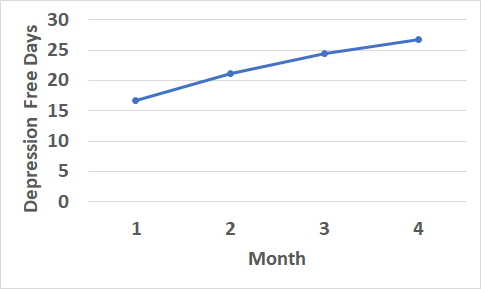|
|

Generated by ChatGPT
Overview
The impact of AI system on patients needs to be monitored carefully to
see if patients benefit from the advice. This section provides
guidance on how to do so for depressed patients.
Objectives
Objectives
- Assess patients health status at a point in time
- Evaluate patient health across 4 point measures
- Report average impact of AI's advice
Assigned Reading
- Use PHQ-9 in point-in-time assessment of patients' symptom of
depression
Read►
Video►
- Analyze 4 measures of depression to report depression-free days
Read►
Background
This tutorial was prepared by ChatGPT and describes how to measure a
patient's depression symptoms using the PHQ-9 and how to calculate
Depression-Free Days over a 4-month period. The PHQ-9 is a widely used tool
to assess the severity of depression symptoms, and it’s crucial in both
clinical practice and research. Student teams should use PHQ-9 and should
not come up with their own questions. Administering a questionnaire
requires a number of steps including: (a) obtain consent at start, (b)
establish contact and in case of failure take corrective action, (c) if
contact is established, then asking planned questions, (d) provide feedback,
(e) anticipate changes in contact information for next attempt, (f) alert
the monitor, for the time being a designated email address, regarding
completion of the task. The following describes the process of
administering the PHQ-9, interpreting the scores, and calculating
Depression-Free Days based on these scores.
Section 1: Administering the PHQ-9
-
What is the PHQ-9?
- The PHQ-9 (Patient Health Questionnaire-9) is a
self-administered tool used to assess the presence and severity of
depression symptoms over the past two weeks. It consists of 9
questions, each scored from 0 (not at all) to 3 (nearly every day),
with a total score ranging from 0 to 27.
-
Administering the PHQ-9:
- Step 1: Write code that asks the 9 questions in PHQ-9
online. You can use online surveys to create
the data collection tool.
- Step 2: Instruct the patient to read each
question carefully and indicate how often they have been bothered by
each of the listed problems over the past two weeks.
- Step 3: Collect the completed questionnaire and
calculate the total score by adding the responses to all nine items.
Each question should receive a score of 0 for not at all, and 3 for
nearly everyday.
-
Interpret the PHQ-9 Score:
- 0-4: Minimal or no depression
- 5-9: Mild depression
- 10-14: Moderate depression
- 15-19: Moderately severe depression
- 20-27: Severe depression
- Note the patient's total score, as it will be used later to
calculate Depression-Free Days.
Section 2: Repeated Measurements Over Time
- Measuring Depression Over Time:
- The PHQ-9 should be administered monthly to track changes in
the patient's depression symptoms. For this example, let’s assume
you are measuring the patient’s depression symptoms monthly over a
4-month period and assessing depression scores every month.
- After administering the PHQ-9 each month, record the scores in a
database without recording patient identification and using an alias. You
should now have four scores, one for each month.
Section 3: Calculate Depression-Free Days (DFDs)
-
Understand Depression-Free Days (DFDs):
- Depression-Free Days (DFDs) represent the number, or portion, of days within
a given period that a patient is considered free from significant
depressive symptoms. It is a useful metric for assessing treatment
effectiveness over time.
-
Use PHQ-9 Scores to Estimate DFDs:
- Step 1: For each PHQ-9 score, determine the
corresponding DFDs using the following formula:
- DFDs = 30 x (1-PHQ-9 score/27)
- This formula assumes that each day in the month has the same
symptoms as the average PHQ-9 score.
- For example, a PHQ-9 score of 10 (Moderate depression) would
correspond to:
- DFDs = 30 x (1-10/27) = 19 DFDs in the month.
- Step 2: Calculate DFDs for monthly meausres.
-
Sum DFDs Over 4 Months:
- Step 1: Add the DFDs for all four months to
calculate the total number of Depression-Free Days over the 4-month
period.
- Step 2: Interpret the results. Higher DFDs
indicate a greater period during which the patient was free from
significant depression symptoms, suggesting an improvement in their
condition.
-
Example Calculation of Depression-Free Days:
- Month 1 PHQ-9 Score: 12 → DFDs = 30 x (1-12/27)
= 17 DFDs
- Month 2 PHQ-9 Score: 8 → DFDs = 30 x (1-8/27) =
21 DFDs
- Month 3 PHQ-9 Score: 5 → DFDs = 30 - (1-5/27) =
24 DFDs
- Month 4 PHQ-9 Score: 3 → DFDs = 30 - (1-3/27) =
27 DFDs
- Total DFDs over 4 months: 17 + 21 + 24 + 27 =
89
Depression-Free Days in 4 months

Conclusion
You've now learned how to measure a patient’s depression symptoms using
the PHQ-9 and how to calculate Depression-Free Days over a 4-month period.
Regular assessment and monitoring of these measures are crucial for
effective depression management and can significantly impact patient
outcomes.
Instruction for Submission of Assignments:
- Provide a summary statement (one sentence per Task).
- Submit you answers in Canvas.
Task 1: Create an online interview for collection of
PHQ9 at different time periods. Make sure that the interview is easy
to take on phone and computers. Make sure that the PHQ-9
questionnaire does not collect any HIPAA restricted information. Store
questionnaire responses in a HIPAA compliant database, encrypted at rest.
-
At end of the interview, transfer the patient to
a separate questionnaire that collects information on payments to
respondents. This questionnaire collects name and contact
information for financial payments. The responses to PHQ-9
questionnaire are not linked to this questionnaire. The link to
the payment questionnaire is automatically generated by the system, is a
one-time use link, and can only be found at end of the PHQ-9 questions.
You are not asked to collect data from real patients and you can
simulate responses to the questionnaire to show that the system works.
-
At end of interview ask if the patient contact
information is changing in the next month. At end of interview ask
for responses to questions that would allow client to bypass password
requests.
Task 2: Create an online system that measures depression
free days from collected data. The system dispatches the questionnaire
at designated intervals to the client. The dispatch of the PHQ-9
questionnaire may not be received by the client. Make sure that you
alert system administrator on emails that are not received. Dispatch the
questionnaire again if the email is received but not read. If after
two trials the questionnaire is not answered, alert the system
administrator. In testing this system, you simulate responses to
dispatch and PHQ9 questionnaires. You do not collect data. You
simulate responses 4 times and obtain 4 point estimates. Then use the
procedures described here to measure depression free days. Display the total
number of the patients enrolled and the average depression free days in any
4 month interval across subjects.
Task 3: Create an online interview that enrolls the
patient into the follow up system, educates them about the needed data
collection, sets id and passwords for next contact, and collects patient's consent.
|
